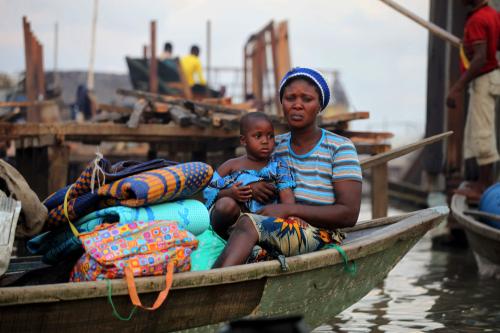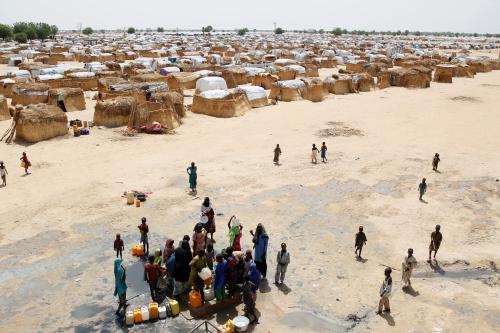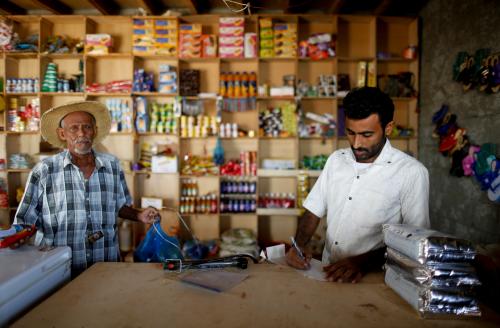One of the highlights of the IMF/World Bank Spring meetings in April was the release by the International Monetary Fund of up-to-date estimates and forecasts through 2022 for global, regional and country specific growth rates along with a range of other macroeconomic variables. For sure, some of the forecasts will not be realized and even historical data will need to be adjusted. However, getting best-available estimates is useful for policy makers and analysts alike to continuously review and improve the underlying assumptions and understanding of the global economy.
The focus on growth alone, however, seems out of place in today’s world where many other issues command attention—poverty, hunger, jobs, health, education, and inequality for example. This raises the question: Would it be possible and desirable to establish current estimates and forward-looking projections for key development indicators, other than GDP, especially for poverty? Enter the World Poverty Clock, available at www.worldpoverty.io. Launched today at the re:publica tech conference in Berlin, it is the first attempt to develop a real-time global model for poverty with projections until 2030.
Measuring global poverty is far from an exact science. So much so, that the Atkinson Commission report felt the need to acknowledge the many economists who believe such exercises are futile. Yet, the same commission report concludes that it is estimations of the change over time of global poverty that are most useful for policymaking.
This realization coincides with the agreement in 2015 of 193 world leaders to adopt sustainable development goals (SDGs) with targets set for 2030. SDG 1, end poverty in all its forms everywhere, has a target of eradicating extreme poverty by 2030.
Can we measure how well we are progressing toward this target? How much is anecdotal guesswork building on partial and often unreliable data? It’s hard to say, but we have to start somewhere.
There has been for some time a new narrative urging us to celebrate the huge reduction in poverty that has taken place since 1990—estimated at well over a billion people. But much of this was due to economic growth that slowed down in 2016. In China and India, most people have already escaped poverty, so the numbers they contribute to global totals are falling. And famine and war have recently devastated some countries.
We know these issues, but we do not yet systematically measure the implications for poverty reduction, in each country, in real time.
The World Poverty Clock launched today puts out numbers on poverty for 187 countries in a transparent way. We know these numbers are imprecise and subject to revision (and with 187 countries we may even have made some mistakes). But we hope there will be many constructive suggestions that will help to improve the data and, more importantly, the quality of discussion on poverty reduction efforts. We think the only way to make progress is by putting out numbers transparently so that our narratives and policy recommendations reflect the best-available information.
The World Poverty Clock
The World Poverty Clock builds upon the combination of new estimates of country-by-country income distributions that can be summed to a world income distribution, and macroeconomic projections of population by age and educational attainment level as well as income per capita. The online tool provides a platform that monitors progress and possible challenges to the eradication of extreme poverty. The analysis and visualization tool contains information on 187 countries and territories, covering 99.7 percent of the world population.
There are three steps in estimating poverty by country. First, we established a baseline for the number of poor people in each country using the latest household survey. (There are now 143 countries with a representative household survey taken within the last decade. For countries without a survey, we model the average relationship between income levels and poverty headcounts and interpolate poverty rates from that.) Second, we “now-casted” the figure to the present assuming everyone’s income grows at the same rate as aggregate household expenditure per capita. Third, we projected poverty forward to 2030 using GDP growth forecasts made by the IMF, complemented by long-term shared socio-economic pathways developed by the OECD and the International Institute for Applied Systems Analysis.
The graph below illustrates the methodology. The survey data gives the shape of an estimated curve describing the number of people in any given income bracket. The headcount of those falling below $1.90 is the number of people living in extreme poverty. Over time, the mean of the curve is shifted to the right to reflect income growth, while inequality is held constant, permitting a recalculation of the number of poor people at any given point in time.
Figure 1: Modeling income distribution and GDP per capita in real time

One unique feature of the poverty clock is that it yields calculations of the speed of poverty reduction. We choose to express this speed as the number of people escaping poverty every second, a metric that acts as a powerful visualization device for the clock. Each country’s speed is compared with the average requirement to meet the poverty target of getting to zero by December 31, 2030. Countries with high levels of poverty need a more rapid poverty reduction speed to meet the target than those with low initial levels. The comparison results in four classifications into which each country fits: “No Extreme Poverty” (less than 3 percent of the population living in poverty), “On-Track” (current speed of poverty reduction exceeds average needed to meet target), “Off-Track” (current speed of poverty reduction will not result in meeting target), or “Poverty is Rising.”
Main results
The world is progressing rapidly toward ending poverty. We estimate that in 2016, 38 million people escaped poverty, and for 2017, we project that another 28 million people will escape poverty. This is cause for celebration but also for concern. The current rate of poverty reduction is still 35 percent below the target of 1.5 people per second that is needed to end poverty by 2030. As of today, there are 16 million more people living in poverty than expected if the SDG 1 target were to be met by a smooth trajectory. So at some point we will need to accelerate progress.
This could be problematic as in many countries with large populations, especially in Asia, the rate of reduction of poverty will decline over time because the numbers still living in poverty will fall to negligible levels. In Asia alone, the speed of poverty reduction is 1.3 people per second, higher than the global escape rate of 1.1 person per second. This means that poverty is rising in all other regions combined.
The challenge is enormous. Poverty is expected to rise in 27 countries (19 in Africa, four in the Americas, three in Asia and one in Oceania). This means that in these countries the number of poor will increase from 287 million people to 345 million by 2030. In a further 35 countries, poverty is declining, but not fast enough; the speed of reduction of poverty must be trebled through 2030. In remaining countries, poverty has either already been or is on track to be eradicated. These countries have found the policies and resources to be successful (Figure 2).
Figure 2: Projection 2030: 490m people living in extreme poverty

Developing solutions for those countries that have stubborn levels of poverty is crucial if we are to meet the SDG target. Even this may not be sufficiently granular. New solutions might be required at the subnational level as poverty is often geographically concentrated and stubborn in selected places. Here too we need more disaggregated data on what is happening. The next phase of the poverty clock will be to drill down into administrative regions within countries.








Commentary
Making everyone count: A clock to track world poverty in real time
May 10, 2017